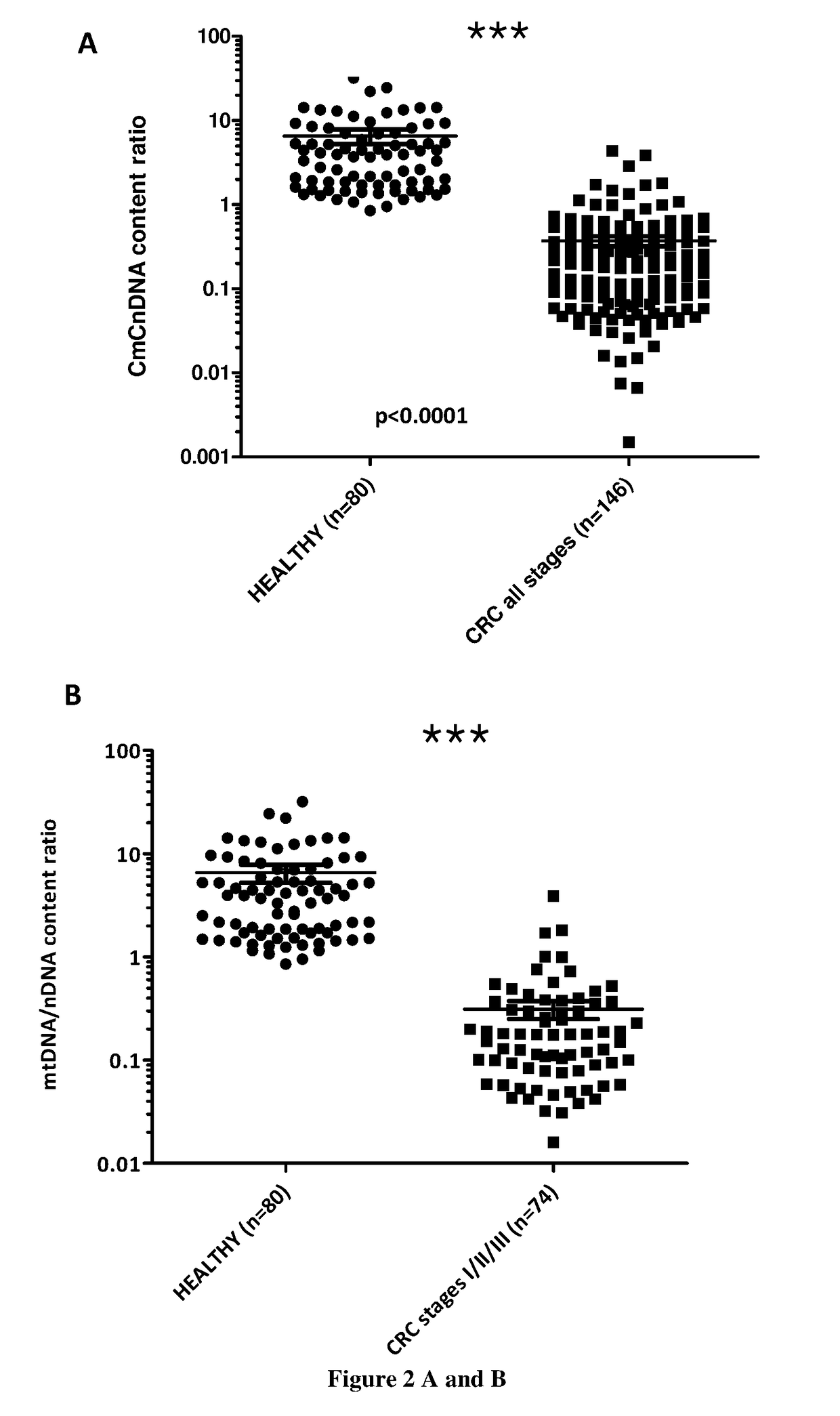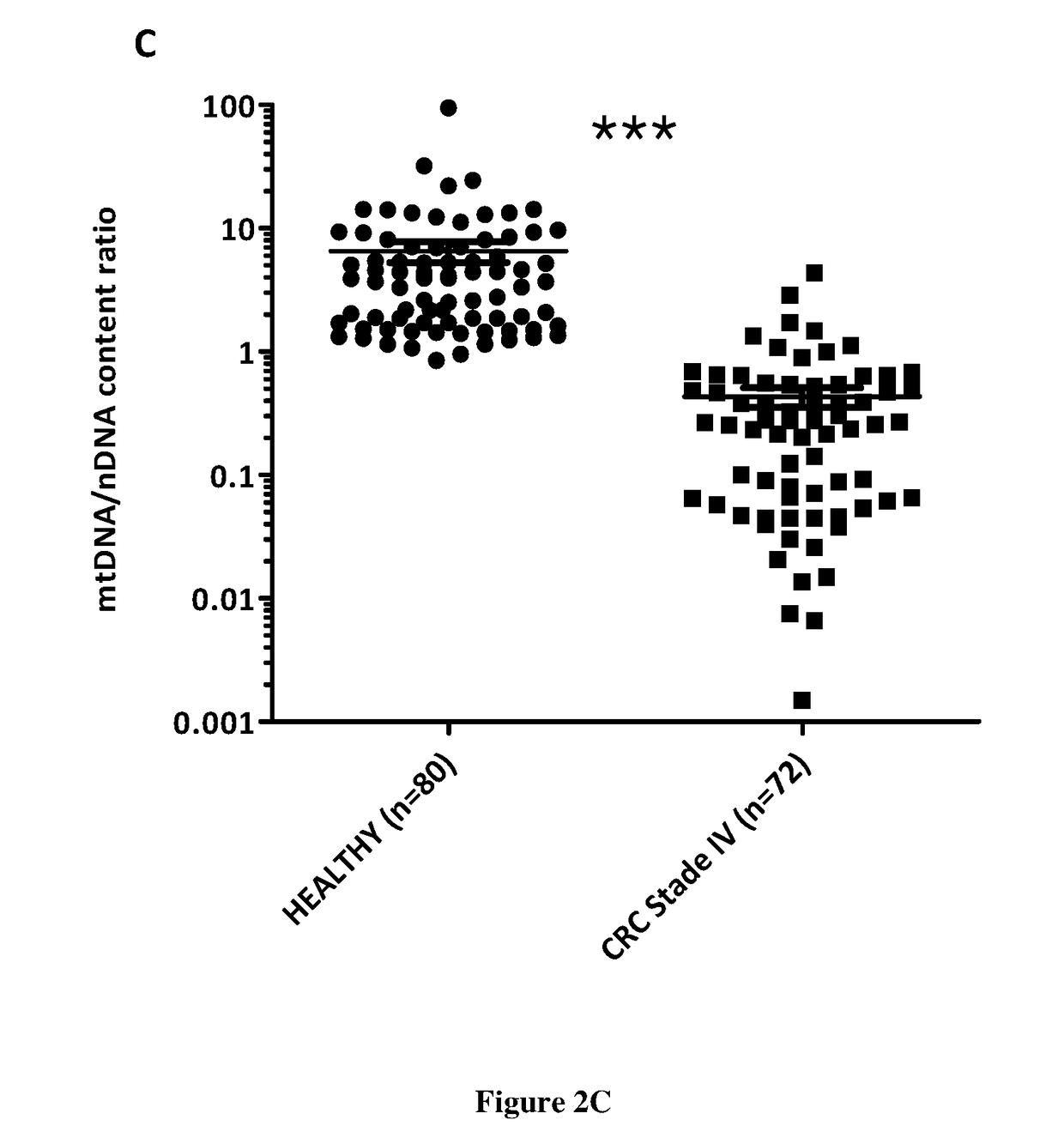Methods for screening a subject for a cancer
a cancer and subject screening technology, applied in the field of cancer screening a subject, can solve the problems of ccfdna concentration not yet being validated as a cancer biomarker, few ccfdna-based tests have been translated to clinical practice, and the structural and size characteristics of ccfdna are still poorly characterized in the literatur
- Summary
- Abstract
- Description
- Claims
- Application Information
AI Technical Summary
Benefits of technology
Problems solved by technology
Method used
Image
Examples
example 1
tion of CmCnDNA Content Ratio in Healthy and Cancer Individuals
[0151]Material & Methods:
[0152]Blood samples from healthy individuals are obtained from the Etablissement francais du sang (EFS convention no 21 / PLER / MTP / INSERM02 / 2013-0073). Blood from CRC patients are obtained from the Kplex 1 and Kplex2 clinical study in which patients have signed an informed consent for genetic analysis from their blood. We also obtained blood samples from cohorts of hospital centers of Clermont-Ferrand and Limoges in France in which patients have signed an informed consent for genetic analysis from their blood. Lung cancer plasma samples come from Manchester Hospital (UK) in which patients have signed an informed consent for genetic analysis from their blood. HepatoCellular Cancer)(HCC° plasma samples were obtained from the CHU of Montpellier) in which patients have signed an informed consent for genetic analysis from their blood.
[0153]Plasma Isolation and Ccfdna Extraction:
[0154]Samples were handle...
example 2
CmCnDNA Content Ratio and Concentration of Total Circulating Nuclear DNA for Discriminating Healthy and Cancer Individuals
[0167]Total concentration of nuclear circulating DNA (CnDNA concentration) in the same cohort of healthy individuals (n=80) and in cancer patients (n=207) was calculated and presented in FIG. 8A. There is a very strong statistic significant difference of CnDNA content in blood between healthy and cancer subjects (p<0.0001). Diagnosis predictive capacity of total ccfDNA concentration to distinguish plasmas from mCRC patients and healthy subjects is presented in FIG. 8B. The ROC Curve representation deriving from the univariate logistic analysis corresponding to total ccfDNA (FIG. 8B, AUC=0.82) confirm it while being slightly lower when using CmCnDNA content ratio. This observation was already made (CNRS Patent and Mouliere et al, Mol. Oncol). It is the subject of the invention to combine both analysis for its improving screen test power. Combination of both biomar...
example 3
tion of CmCnDNA DII Ratio in Healthy and Cancer Individuals
[0170]Integrity can be evaluated by determining the DNA integrity index (DII) calculated as the ratio of the content of circulating DNA fragment over the content of circulating DNA fragment of a lower size. Typically we can use Q-PCR analysis: for each DNA extract long nuclear KRAS amplicon of 305 bp and long mitochondrial MT-CO3 amplicon of 296 bp were quantified in separate run. Nuclear and Mitochondrial DII were calculated by the ratio of the concentration determined with the primer set targeting a long sequence to the concentration determined with the primer set targeting a 67 bp region. DII of each samples of the both groups of individuals are shown in Table 3. Although diagnosis capacity is much lower than that of CmCnDNA content ratio, CmCnDNA DII ratio has diagnosis power which might be combined or associated with CmCnDNA content ratio.
TABLE 3Diagnostic capacity of the CmCnDNA DII ratio. DII, DNA Integrity Index.HEAL...
PUM
| Property | Measurement | Unit |
|---|---|---|
| concentration | aaaaa | aaaaa |
| temperature | aaaaa | aaaaa |
| temperature | aaaaa | aaaaa |
Abstract
Description
Claims
Application Information
 Login to View More
Login to View More - R&D
- Intellectual Property
- Life Sciences
- Materials
- Tech Scout
- Unparalleled Data Quality
- Higher Quality Content
- 60% Fewer Hallucinations
Browse by: Latest US Patents, China's latest patents, Technical Efficacy Thesaurus, Application Domain, Technology Topic, Popular Technical Reports.
© 2025 PatSnap. All rights reserved.Legal|Privacy policy|Modern Slavery Act Transparency Statement|Sitemap|About US| Contact US: help@patsnap.com



